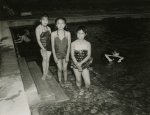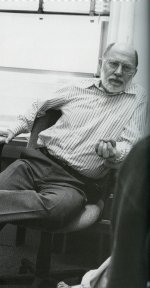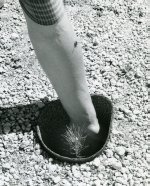
This hydraulic model of Pelton Dam was constructed under the direction of Professor Roy Shoemaker of Oregon State College's Civil Engineering Department. Portland General Electric Co., which was building the dam, was concerned with the location of a "skimmer" device to help fish migrate past the dam and had OSC construct the model, which produced the exact conditions of dam operation.
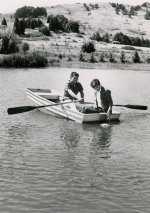
(P120:1166)
Warm Springs youth participate in the OSU Extension Service's Wildlife Management Short Course, July 1966.
Youth from the Warm Springs Indian Reservation came to OSU and participated in a variety of activities, including tours of the Game Lab, the Oak Creek Fisheries Lab, the Drift Creek Research Project and the Lint Slough Salmon and Steelhead Production Project.
OSU and the Confederated Tribes of Warm Springs have partnered on many endeavors, including Extension Service activities. Extension work was established on the Warm Springs reservation in 1955 with programs in agricultural production, family living, 4-H club work, home improvement, and livestock.
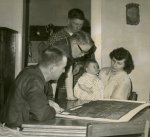
(P095:061)
The Manwiller family looking at materials supplied by Deschutes County Agent Jane Schroeder, September 1959.
The Manwiller family of Bend found the materials from their county Extension Office useful in planning their new home. Included (l. to r.) in the photo were Don Manwiller, sons David and Donnie, daughter Debra, and wife Rachel.
Johnson served as the first superintendent of the branch station beginning in 1948, when it was known as the Deschutes Experimental Project, until his retirement in 1980.
O'Connor, head advisor for OSU's College of Liberal Arts, also served as the advisor for the university's Liberal Studies program in Bend.
The trees were planted in 1961 by OSU forestry researchers in area where no trees had grown for hundreds of years because of severe climatic and growing conditions. Loosening the pumice and protecting the seedlings from drying winds with a ring of asphalt roofing resulted in excellent growth and survival of the seedings.

(P092:1360)
Memorandum of Understanding between the Confederated Tribes of Warm Springs Indian Reservation and Oregon State University, March 28, 1991.
Building upon their long-term relationship, the Confederated Tribes of Warm Springs and OSU agreed to additional collaboration, particularly in the areas of natural resources management and education.



